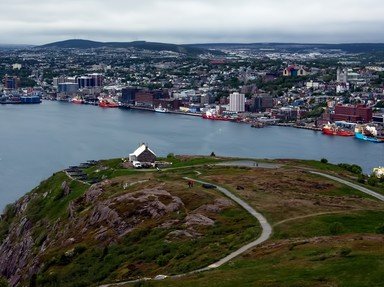Quiz Answer Key and Fun Facts
1. We begin our trip at the easternmost point of Newfoundland (and of Canada), where a lighthouse sits on the rocky shoreline at Cape Spear. What was the name given to this site by early Portuguese explorers, which translates as 'Cape of Hope'?
2. A 20-minute drive from Cape Spear will bring you to Signal Hill, where the world's first transatlantic wireless signal was received by Guglielmo Marconi in 1901. Cabot Tower, pictured here, began construction in 1897 to commemorate the 400th Anniversary of Cabot's "Voyage of Discovery", as well as for what other event?
3. In 1583, Sir Gilbert Humphrey arrived in St. John's Harbour and laid claim to the land for England under a Royal Charter. This was the first colonial claim of what would become the British Empire. Who was the monarch at the time?
4. Leaving St. John's, it is a little bit more than a three hour northerly drive to find the North Atlantic Aviation Museum on the Trans Canada Highway. In what town, that gained international fame during the 9/11 crisis when many airplanes were diverted there, can it be found?
5. In 1878, a record-setting giant squid was found and captured on the shore of what is today known as Glover's Harbour (on the northern coast). At the time, however, the fishing village had not yet been established. What was the region (and the specimen) originally called, funnily enough?
6. From Glover's Harbour it takes nearly four hours of driving to reach Corner Brook on Newfoundland's west coast. Looking out over the Bay of Islands stands a statue of which explorer, who mapped the coastline of the entire island in the 1760s?
7. Turning north and just an hour's drive away from Corner Brook is Gros Morne National Park. This breathtaking region takes its name from the island's second-highest peak (807 m). What is the most literal translation of 'Gros Morne'?
8. Continuing nearly 400 km north to the tip of the Great Northern Peninsula we find L'Anse aux Meadows National Historic Site. Dating from approximately 1,000 CE, the buildings discovered here (in the 1960s) have been authenticated as being Norse in origin.
9. Approximately 75 km due north of L'Anse aux Meadows lies a small island off the east coast of Labrador. Battle Harbour (on Battle Island) became the capital and largest community in Labrador, primarily due to what industry?
10. After catching the ferry back to Newfoundland, a six-hour drive will bring you to Port aux Basques in the southwest corner of the island and another ferry that will take you to Nova Scotia. Depending on weather, how long does it take for the ferry to reach North Sydney, NS?
Source: Author
reedy
This quiz was reviewed by FunTrivia editor
agony before going online.
Any errors found in FunTrivia content are routinely corrected through our feedback system.
